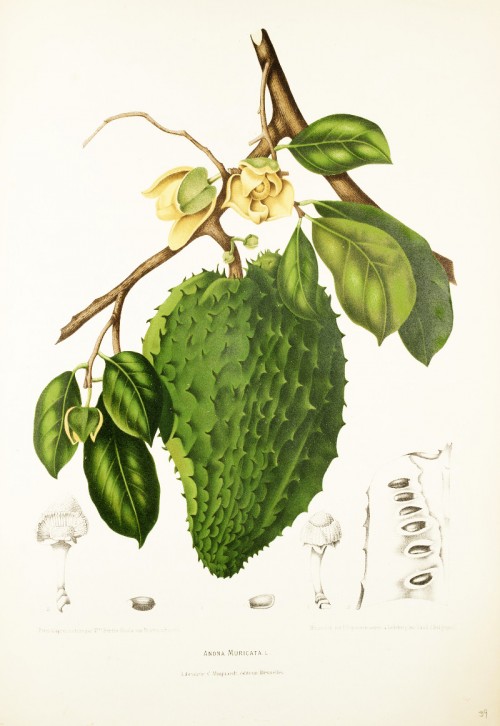Dies ist eine alte Version des Dokuments!
Annona muricata L. - Annonaceae - soursop, Guanábana, Graviola (port.), Stachelannone, Sauersack
Evergreen tree, up to 4(-10)m high, probable native to the West Indies, widely naturalized and cultivated in tropics.
„The fruit is usually called soursop due to its slightly acidic taste when ripe.“ http://en.wikipedia.org/wiki/Annona_muricata
„The fruit, soursop, is the largest among Annona species. It is eaten raw, used in sherbets, and used in drinks. The pulp is also consumed with wine or cognac.“ http://www.efloras.org/florataxon.aspx?flora_id=2&taxon_id=200008507
„The volatile compounds in soursop (Annona muricata L.) were obtained by a liquid-liquid continuous extraction procedure from the aqueous solution of blended soursop pulp and analyzed by gas chromatography (GC) and GC-mass spectrometry (MS). Twelve volatiles were identified by comparing their mass spectra and Kovats retention indexes with those of standard compounds: five were identified tentatively from MS data only, eight are being reported for the first time. (Z)-3-hexen-1-ol was the main volatile present in mature-green fruit, while methyl (E)-2-hexenoate, methyl (E)-2-butenoate, methyl butanoate, and methyl hexanoate were the four main volatiles present in ripe fruit. Concentrations of these five volatiles decreased and several other unidentified volatiles appeared when the fruit became overripe.“
[Identifying volatiles in soursop and comparing their changing profiles during ripening., Iwaoka, Wayne T., et al., HortScience Vol.28(8), 1993, 817-819]
„The essential oil of the exotic fresh fruit (pulp) Annona muricata (Annonaceae) from Cameroon was investigated by gas chromatographic/spectroscopic (GC/FID and GC/MS) and olfactoric methods to identify those constituents responsible for the intense and characteristic odor of this local foodstuff. Esters of aliphatic acids are especially dominating (total amount ∼51%), with 2-hexenoic acid methyl ester (23.9%), 2-hexenoic acid ethyl ester (8.6%), 2-octenoic acid methyl ester (5.4%), and 2-butenoic acid methyl ester (2.4%) as main compounds. Additional mono- and sesquiterpenes such as β-caryophyllene (12.7%), 1,8-cineole (9.9%), linalool (7.8%), α-terpineol (2.8%), linalyl propionate (2.2%), and calarene (2.2%) are highly concentrated in the essential oil of the fresh fruit of A. muricata. The use of this essential oil exhibiting a very pleasant odor in flavoring is discussed.“
[Essential oil compounds of the Annona muricata fresh fruit pulp from Cameroon., Jirovetz, L., Buchbauer, G., Ngassoum, M. B., Journal of Agricultural and Food Chemistry, Vol.46(9), 1998, 3719-3720]
„Bioactivity-directed fractionation of the seeds of Annona muricata L. (Annonaceae) resulted in the isolation of five new compounds: cis-annonacin (1), cis-annonacin-10-one (2), cis-goniothalamicin (3), arianacin (4), and javoricin (5). Three of these (1−3) are among the first cis mono-tetrahydrofuran ring acetogenins to be reported. NMR analyses of published model synthetic compounds, prepared cyclized formal acetals, and prepared Mosher ester derivatives permitted the determinations of absolute stereochemistries. Bioassays of the pure compounds, in the brine shrimp test, for the inhibition of crown gall tumors, and in a panel of human solid tumor cell lines for cytotoxicity, evaluated relative potencies. Compound 1 was selectively cytotoxic to colon adenocarcinoma cells (HT-29) in which it was 10 000 times the potency of adriamycin.“
[Five novel mono-tetrahydrofuran ring acetogenins from the seeds of Annona muricata., Rieser, M.J., Gu, Z.M., Fang, X.P., Zeng, L., Wood, K.V., McLaughlin, J.L., Journal of Natural Products, 59(2), 1996, 100-108]
„Atypical parkinsonism in Guadeloupe has been associated with the consumption of fruit and infusions or decoctions prepared from leaves of Annona muricata L. (Annonaceae), which contains annonaceous acetogenins, lipophilic inhibitors of complex I of the mitochondrial respiratory chain. We have determined the concentrations of annonacin, the major acetogenin in A. muricata, in extracts of fruit and leaves by matrix-assisted laser desorption-ionization mass spectrometry. An average fruit is estimated to contain about 15 mg of annonacin, a can of commercial nectar 36 mg, and a cup of infusion or decoction 140 μg. As an indication of its potential toxicity, an adult who consumes one fruit or can of nectar a day is estimated to ingest over 1 year the amount of annonacin that induced brain lesions in rats receiving purified annonacin by intravenous infusion.“
[Quantification of acetogenins in Annona muricata linked to atypical parkinsonism in Guadeloupe., Champy, P., Melot, A., Guérineau Eng, V., Gleye, C., Fall, D., Höglinger, G.U., Hocquemiller, R., Movement Disorders, 20(12), 2005, 1629-1633]

Hoola van Nooten, B., Fleurs, fruits et feuillages choisis de l’ille de Java: peints d’apres nature, t.39 (1880)
http://plantgenera.org/species.php?id_species=66322
